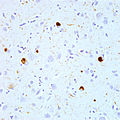Dementia with Lewy bodies
Dementia with Lewy bodies (DLB), also known as diffuse Lewy body disease, cortical Lewy body disease, and senile dementia of Lewy type, is a type of dementia accompanied by changes in sleep, behavior, cognition, movement, and automatic bodily functions. It is characterized by the presence of Lewy bodies, parts of alpha-synuclein and ubiquitin protein in neurons, detectable in post mortem brain histology.[1] Lewy body dementia affects 1.3 million individuals in the United States alone.
Dementia With Lewy Bodies Media
A ribbon diagram of apolipoprotein E. Variants of this protein influence the risk of developing DLB.[2]
This photomicrograph shows brown-immunostained alpha-synuclein in Lewy bodies (large clumps) and Lewy neurites (thread-like structures) in the neocortical tissue of a person who died with Lewy body disease.
Positron emission tomography, for example, using PiB is helpful in the diagnosis of DLB.[3][4]
References
- ↑ Van Gerpen, Jay A.; Assn, Lewy Body Dementia (2007), New Trends in Lewy Body Dementia, from "The Many Faces of Lewy Body Dementia" series at Coral Springs Medical Center, FL, YouTube
- ↑ Walker and others 2015, p. 1684.
- ↑ McKeith and others 2017, sec. "Summary of changes", pp. 88–92.
- ↑ Hansen and others 2019, p. 639.
- ↑ Gallman 2015.
- ↑ Williams 2016.
- ↑ Robbins 2016.



